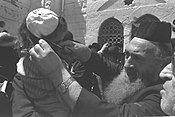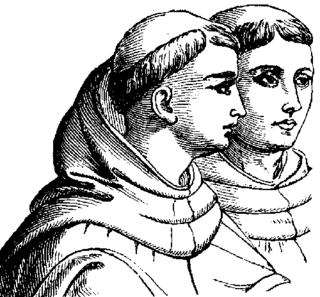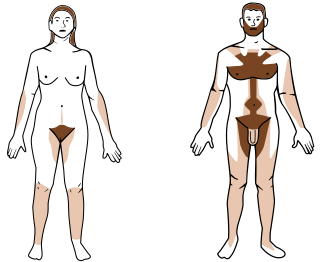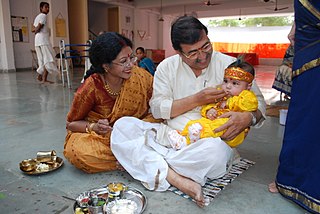
The first haircut for a human has special significance in certain cultures and religions. It can be considered a rite of passage or a milestone.

The first haircut for a human has special significance in certain cultures and religions. It can be considered a rite of passage or a milestone.
In Hindu tradition, from birth, hair is associated with less positive aspects of or qualities from past lives. [1] Thus at the time of the shave, the child is freshly shaven to signify freedom from the past and moving into the future. [2] It is also said that the shaving of the hair stimulates proper growth of the brain and nerves, and that the sikha, a tuft at the crown of the head, protects the memory. [2]
Hindus practice a variety of rituals from birth to death. Collectively these are known as saṃskāras , meaning rites of purification, and are believed to make the body pure and fit for worship. A boy's first haircut, known as choula or mundan, is one such samskara and is considered an event of great auspiciousness. [3] The lawbooks or smritis prescribe that a boy must have his haircut in his first or third year, though when a family does it varies in practice. [4] A girl's first haircut typically occurs at eleven months of age. [1]
While complete tonsure is common, some Hindus prefer to leave some hair on the head, distinguishing this rite from the inauspicious tonsure that occurs upon the death of a parent. Those that practice complete tonsure generally ritually offer the hair to their family deity. Many travel to temples such as the famed Tirumala Venkateswara Temple of Lord Vishnu to perform this ceremony.
At the twentieth day from birth, Maliku babies' heads are shaven and the hair is weighed against gold or silver, which is given to the poor.[ citation needed ] The ceremony is called boabeylun.
Mongolian children get their first haircut in early ages between 2–5. Depending on the lunar calendar, boys receive their first hair cut in their odd year and girls in even year. The ritual of cutting the first hair is called Sevleg Urgeeh or Daahi Urgeeh. It is a big occasion for a whole family when guests are invited. Each guest cuts a strand of hair, saying their best wishes to the child, and gives a gift and money.

Many Orthodox and Hasidic Jewish boys get their first haircut when they are three years old. The hair-cutting ceremony is known in Yiddish as the upsherenish or upsherin ("shear off"), and in Hebrew as halaqah (from the Arabic حلاقة - "to shave").
In Israel, there are also non-religious families who adhere to this custom and do not cut their sons' hair until the age of three. A mass hair cutting ceremony is held on the holiday of Lag BaOmer at the tomb of Rabbi Simeon bar Yohai in the Galilean town of Meron.
The Aqiqah ceremony involves shaving the child's head seven days after birth and anointing the child's head with saffron. [5] It is traditional to give in charity gold or silver equal in weight to the hair. [5] This does not have to be done by actually weighing the hair; if it is too difficult to do that, it is sufficient to estimate the weight and give paper currency equivalent to the price of that amount of gold or silver.
The ritual first haircut (Polish : postrzyżyny) was a pre-Christian pagan-Slavic tradition which survived in Poland well into the 18th century. This first haircut traditionally took place between the ages of 7 and 10, and was conducted by either the boy's father or a stranger, who would thus enter into the boy's family. [6] Before that age the boy's life was connected to his mother and he was treated as a child. The ritual haircut, coupled with the granting of an additional given name (usually the third), marked the boy's coming of age and a transition to the world of men, in which he was to be looked after by his father. [7] The ritual also constituted the father's formal act of recognition of the boy as a son. [7]
Ukrainian babies often have their hair cut on their first birthday as part of the ancient Postryzhennya custom. [8]
In Cook Islands tradition, the haircutting ceremony is a rite of passage for young boys. At these large gatherings the boy sits on a chair draped with tīvaevae (quilts). As his hair is cut, members of the community plaster the boy with money or other gifts. The custom serves to maintain reciprocal ties within the extended family and community. [9]
Traditionally, Niuean boys do not cut their hair, which is lovingly cared for by sisters, mothers and fathers. When the boys become teenagers, a ceremony is held where women tend the hair for the last time before it is cut. Members of the extended family plaster the youth with banknotes – all part of a large informal Niuean economy that links families and ensures the community looks after its own. [10]
Malaysian children get their first haircut after the mother's confinement period is over, this can be from around 40–44 days long but more recently it has been done in as few as 20 days. [11] After this period is over it is common to invite extended family over for the ceremony of cutting the child's hair. This ceremony is called Cukur Jambul. The purpose of Cukur Jambul is to welcome the new baby into the clan, it also serves the secondary purpose of allowing extended family to renew their relations with each other. After Cukur Jambul has started with a reading from the Quran, the father or mother takes the child to everyone who will cut some of the baby's hair, these people usually include grandparents, members of the marhaban group, local elders, and religious leaders. It is customary for those who do the cutting to gift the baby with something small, like a little cash. The hair is often weighed in order to donate its weight in gold, or the more convenient equivalent, to the poor. It is later put into some sort of bowl and buried in front of close family members in order to finish the ceremony. [12]
Some Native American tribes commemorated the first haircut with a ritualistic dance. The Apache tribe had a springtime ritual.
Within the African Caribbean community this is performed once the child begins to speak clearly or after the child reaches two. This is usually done in a barbershop or carried out by the parent.
In the Yazidi tradition (mainly in Iran), the bisk ceremony involves cutting of a baby boy's two or three first locks, according to old traditions by his 40th day after birth to be given to the family's shaikh and pir, but in modern practice at 7 to 11 months, and kept by the family. The bisk ceremony is regarded as the central initiatory ritual by most Yazidis from Turkey, Armenia and Syria. In the European Diaspora, the term is often translated as baptism. The ceremony is reminiscent of the Muslim 'aqiqa celebrated on the seventh day after birth, but the Yazidi ceremony takes place at a later stage, when the child has already been named.

Tonsure is the practice of cutting or shaving some or all of the hair on the scalp as a sign of religious devotion or humility. The term originates from the Latin word tonsura and referred to a specific practice in medieval Catholicism, abandoned by papal order in 1972. Tonsure can also refer to the secular practice of shaving all or part of the scalp to show support or sympathy, or to designate mourning. Current usage more generally refers to cutting or shaving for monks, devotees, or mystics of any religion as a symbol of their renunciation of worldly fashion and esteem.

Hair removal, also known as epilation or depilation, is the deliberate removal of body hair or head hair.

Shaving is the removal of hair, by using a razor or any other kind of bladed implement, to slice it down—to the level of the skin or otherwise. Shaving is most commonly practiced by men to remove their facial hair and by women to remove their leg and underarm hair. A man is called clean-shaven if he has had his beard entirely removed.

Coming of age is a young person's transition from being a child to being an adult. The specific age at which this transition takes place varies between societies, as does the nature of the change. It can be a simple legal convention or can be part of a ritual or spiritual event.

Upanayana is a Hindu educational sacrament, one of the traditional saṃskāras or rites of passage that marked the acceptance of a student by a preceptor, such as a guru or acharya, and an individual's initiation into a school in Hinduism. Some traditions consider the ceremony as a spiritual rebirth for the child or future dvija, twice born. It signifies the acquisition of the knowledge of and the start of a new and disciplined life as a brahmacharya. According to the given community and region, it is also known by numerous terms such as janai or janea, poita/paita, logun/nagun, yajnopavita, bratabandha, bratopanayan, and mekhal. The Upanayanam ceremony is arguably the most important rite for Brahmin and Kshatriya male, ensuring his rights with responsibilities and signifying his advent into adulthood.

A baby shower is a party centered on gift-giving to celebrate the delivery or expected birth of a child. It is a rite of passage that celebrates through giving gifts and spending time together.

Upsherin, Upsheren, Opsherin or Upsherinish is a first haircut ceremony observed by a wide cross-section of Jews and is particularly popular in Haredi Judaism. It is typically held when a boy turns three years old.

A shikha is a tuft of hair kept at the back of the head by a Hindu following tonsure. Though traditionally considered to be an essential mark of a Hindu, today it is primarily worn among Brahmins, especially those serving as temple priests.

Samskara are sacraments in Hinduism and other Indian religions, described in ancient Sanskrit texts, as well as a concept in the karma theory of Indian philosophies. The word literally means "putting together, making perfect, getting ready, to prepare", or "a sacred or sanctifying ceremony" in ancient Sanskrit and Pali texts of India.

The Chudakarana or the Mundana, is the eighth of the sixteen Hindu saṃskāras (sacraments), in which a child receives their first haircut.

Pumsavana is the second of the 16 saṃskāras in ancient texts of Hinduism. The rite of passage is celebrated in the third or fourth month of pregnancy, typically after the pregnancy begins to show but before the baby begins to move in the womb.

Judaism prohibits shaving with a razor on the basis of a rabbinic interpretation of Leviticus 19:27, which states, "Ye shall not round the corners of your heads, neither shalt thou mar the corners of thy beard." The Mishnah interprets this as a prohibition on using a razor on the beard.

A naming ceremony is a stage at which a person or persons is officially assigned a name. The methods of the practice differ over cultures and religions. The timing at which a name is assigned can vary from some days after birth to several months or many years.
Pumsavana Simantonayana is a combined performance of the two Hindu rites of Pumsavana and Simantonnayana, practised during the contemporary period.
Jatakarman is one of the major samskaras in Hinduism, that celebrates the birth of a child. It is typically a private rite of passage that is observed by the new parents, relatives of the baby and close friends.
Namakarana is the naming ceremony in Hinduism and a samskara to name a baby.
Simantonnayana or Simantha, is the third of the 16 Saṃskāras in the ancient texts of Hinduism. It is observed in the last trimester of pregnancy to wish for safe delivery and is similar to a baby shower.
ʾAqīqah, aqeeqa, or aqeeqah is the Islamic tradition of the sacrifice of an animal on the occasion of a child's birth. Aqiqah is a type of sadaqah and it is also sunnah, though not obligatory.

Kagganapalli Radha Devi is an Indian activist who successfully protested against a Hindu temple that would only employ male barbers. The Venkateswara Temple, Tirumala, which gathers over a ton of hair every day, agreed to also employ female barbers to carry out the ritual tonsuring. Devi received the Nari Shakti Puraskar in recognition of her work.

The Twelve Auspicious Rites are a series of worldly rites of passage recognized in traditional Burmese culture, particularly by the Bamar and Rakhine peoples. These are distinct from the Thirty-eight Buddhist Beatitudes described in the Maṅgala Sutta.